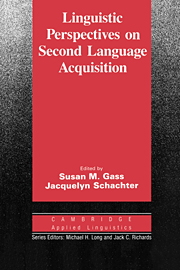Book contents
Chapter 9 - Canonical typological structures and ergativity in English L2 acquisition
Published online by Cambridge University Press: 05 October 2012
Summary
Discussions of the discrepancy between grammatical knowledge and its experiential basis in the primary data of acquisition usually focus on the question of how to account for the attainment of the correct adult grammar. Yet this disparity between knowledge and input data is also apparent in provisional solutions learners arrive at in formulating a grammar. As Lightfoot (1982) points out, of the many logically possible interim solutions that could be derived from the data, only a narrow range is actually attested. Not infrequently these have no obvious model in the target or the first language. It is noncontroversial, by now, that no known inductive learning procedure can satisfactorily account for these salient aspects of acquisition and that innate, specifically linguistic, constraints must mediate the acquisition process. These constraints define the domain for a theory of Universal Grammar.
We can conceive of these constraints as grammatical principles. Universal Grammar will consist of invariant principles which dictate the form grammars can take. Besides these, there are other principles admitting of variation. The manner of their implementation gives rise to the typological variation observable in languages. Since typological variation is sharply circumscribed, and since there is no historical evidence that new linguistic types have evolved (Wode 1981), these principles, too, appear to form part of our biological endowment.
Assume, then, that grammar construction is mediated by principles in such a way that a learner is programmed to search out those data that indicate their manner of implementation.
- Type
- Chapter
- Information
- Linguistic Perspectives on Second Language Acquisition , pp. 203 - 221Publisher: Cambridge University PressPrint publication year: 1989
- 43
- Cited by



